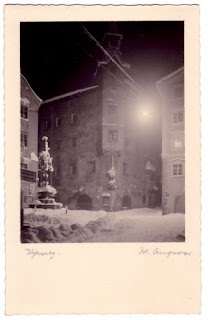Ivan Olbracht - Land Without a Name

Sergej Protopopov - Chimneys in Banská Stiavnica
(Modernism in Central Europe - Exhibition at the Washington National Gallery)
They say the finest German is spoken in Prague, and the finest Czech in Vienna.
Sergej Protopopov was born in Russia and lived in Slovakia. His Chimneys in Banská Stiavnica is one of the most appealing photographs seen in the exhibition from the Washington National Gallery. Was Protopopov trying to recreate a bit the universe of Hokusai? Just a little bit?
Here is another work of Sergej Protopopov, also exhibited at the Washington National Gallery. The title is Mechanical Drilling.

Lowlands was made around 1925, by Gyula Pap: a tired donkey on an endless country road. An image of the Central European space, as a road starting anywhere, ending somewhere beyond horizon?

Olga Spolarics and Adorjan Wlassics were both Hungarians with Slavonic names. They lived in Vienna. Perfect example of Central European mixtum compositum.
Man sagt das feinste Deutsch ist in Prag gesprochen und den feinsten Tschechen in Wien.
The phone directory in Berlin, full of names that are Serbian, Polish, Czech. Names of families that have lived in Berlin for generations.
What ethnicity are exactly the Ruthenians? Or the Székely? Or the Hutzuls? (one of Parajanov's masterpieces, Shadows of Forgotten Ancestors, is about them).
Ivan Olbracht published in 1932 a book about Ruthenia. It had been part of the Austrian-Hungarian Empire. It was in 1932 part of Czechoslovakia. It is now in Ukraine. It had been the object of endless competing claims. For Olbracht, it was a land without a name, as it had so many competing names. Far from being a bedrock of ethnic purity, it was, like any part of Central Europe, a complicated network of ethnicities, and languages, and religions. So, Olbracht chose ironically the title of Land Without a Name for his book.
Central European lands, without names because of too many names. without borders, because of too many borders.
The book of Olbracht is also exhibited at the Washington National Gallery. As well as some works of the representatives of the Heimatfotographie, making the case for the opposite theories, of unitary ethnic structures.
Here are two images by one of the most significant artists of the Heimatfotographie: Wilhelm Angerer - Townhall in Winter and Song of the Blessed:


(Modernism in Central Europe)

0 Comments:
Post a Comment
<< Home